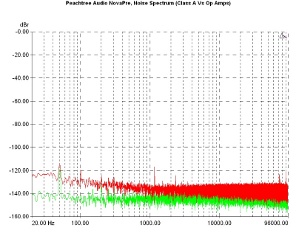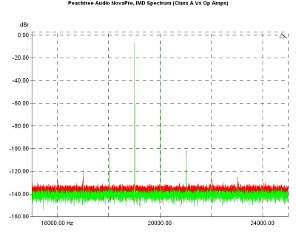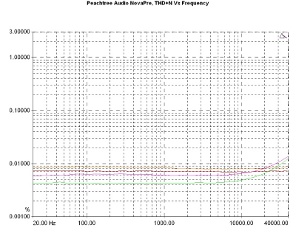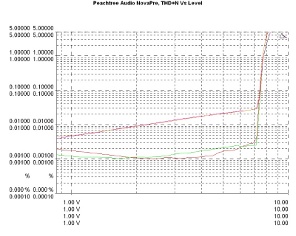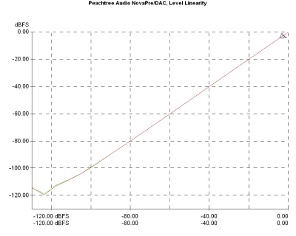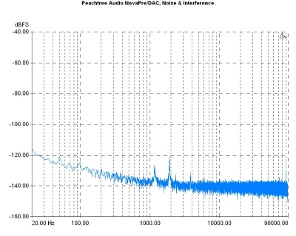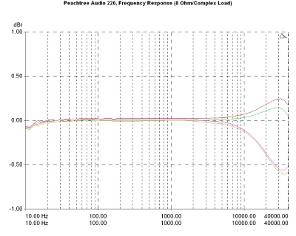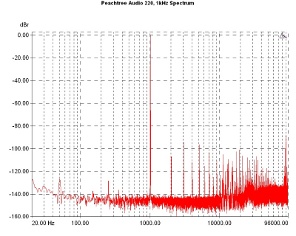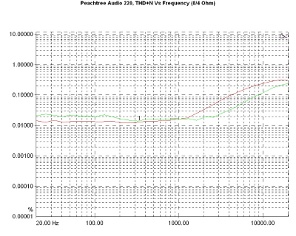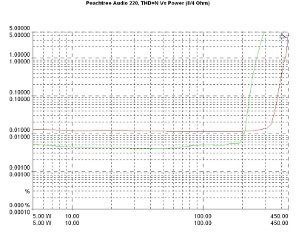about Audio, High Fidelity
& Home Entertainment technologies
pid: 607-2025/10/01 (v1.2)
Privacy Policy

NovaPre lab evaluation included standard preamplifier measurements through the analog input as well as DAC-oriented measurements with 24bit/96kHz signals in one of the two coaxial inputs. Given the option to use two different output stages and the tube buffer, we tried all the possible combinations. Where there are interesting findings, there is a relevant comment.
The preamplifier proved to be of quite typical sensitivity, as it requires 345mV for a 1Vrms output. Note that the sensitivity varies somewhat, depending on the output configuration. The 345mV are for the discrete output, while the corresponding values for the op amp, the hybrid op amp and the hybrid discrete output configurations were 388mV, 358mV and 402mVrms respectively. This behavior will make the user's life a bit difficult when he will -unavoidably- try to compare the different options and it is, probably, something that Peachtree should be more attentive to.
Static distortion measurements were at the low side. The discrete output stage measured about 0.005% (THD+N, 1Vrms) while the op amp output stage is even better, at approximately 0.003%. In hybrid mode, as you would expect, the values are a bit higher, at 0.006% (discrete) and 0.005% (with op amps). The overload margins are sufficiently high. Near the output clipping point, the level was 7.6Vrms, for a 2.6Vrms input (using the discrete output stage).
Static noise measurements were, also quite good. Using the discrete output, the relevant figure was -91dBr(A) (for 1Vrms output as a reference) while the op amps proved even better, at -97dBr(A). Using the tube buffer did not worsen significantly the noise figures in any case. Channel cross-talk was in typical levels for the discrete output stage (-74dBr) and significantly better, at -90dBr, for the op amp stage. The tube buffer seems to reduce the performance at this point. In hybrid-op amp mode, the cross-talk figure falls to -80dBr.
Volume tracking was satisfactory, especially at low attenuation values i.e. in positions higher than the half of the total track. There we measured differences between the two channels in the vicinity of 0.1dB. The performance falls as the attenuation increases, up to about 1dBr for positions in the vicinity of one quarter of the total potentiometer track.
Frequency response of the preamplifier is extensive (-0.3dBr at 75kHz) with a slight cut-off towards the lows that is increased slightly when the tube buffer is activated. Differences between the channels are less than 0.1dB.
The output spectrum for a 1kHz input signal includes a series of harmonics, all of which is under -100dBr as well as minimal high frequency noise components (near the limit of measurement range), also under-100dBr. The comparison between the spectra of the discrete output stage and the op amp output stage reveals that the second is generally quieter, although there are no noticeable differences in level and composition of the harmonics.
Frequency response for both channels. Reference level (0dBr): 1Vrms. Discrete output stage in class A (red/green curve), hybrid mode (discrete/tube, orange/violet)
Spectrum analysis with 1kHz signal input, reference level: 1Vrms. Discrete output stage (red curve), Operational Amplifiers output stage (green).
On the contrary, the comparison between op amp stage with hybrid-op amp stage (i.e. adding the tube buffer) clearly reveals a stronger second harmonic (more than 10dBr). Amazingly, without the tube stage, the preamp seems to have more hum noise, a phenomenon that has no obvious explanation based on the data we have.
Still on the subject of noise, spectral analysis confirms the static measurements with the discrete output being more noisy than the op amp stage, especially in the region below 1kHz.
Spectrum analysis with 1kHz signal input, reference level: 1Vrms. Operational Amplifiers output stage (green curve), hybrid mode (op amps/tube, red).
Output Noise spectrum. Reference level: 1Vrms, input shorted. Discrete stage (red curve), op amp stage (green).
Intermodulation spectrum (19/20kHz 1:1 ratio) includes a number of components with the expected distribution, but as a whole appears to be under-100dBr, a quite good performance indeed. Static intermodulation measurements were also very low (0.001% for the discrete output, 0.0006% for the op amp stage and 0.003% for the both hybrid outputs).
Harmonic distortion Vs frequency graph did not exceed 0.009% up to 10kHz for all available output combinations. From this frequency point up, the preamp in hybrid mode shows a mild upward trend, with values not exceeding 0.015% at the 20kHz limit.
Intermodulation spectrum 19kHz/20kHz 1:1. Discrete stage (red curve), op amp stage (green).
THD+N Vs frequency and output level. Reference level (0dBr): 1Vrms. Discrete stage (red curve), op amp stage (green), discrete/hybrid (orange), op amp/hybrid (violet).
THD+N Vs output level followed the expected behavior, with the hybrid output offering higher figures of distortion in general. Output overload starts just over 7Vrms.
The digital interface of the preamplifier appears to be quite good in suppressing incoming jitter as the attenuation curve lies in most part, under -40dBr. This means that the device will work well with digital sources and cables of moderate quality on this aspect. The device seems to introduce very low jitter, about 16pS, a value which is very good given the price tag of NovaPre.
DAC level linearity was also extremely satisfactory with any visible deviation lying below -110dBFS, a performance which is one of the best we have seen lately.
Jitter attenuation. Jitter signal 80nS pp, S/PDIF input.
Level linearity. 1kHz signal, S/PDIF input.
Wide band noise levels are very low with an upward trend in the low part of the spectrum but almost no findings worth mentioning in the high frequency area. This measurement was done with the discrete output stage.
Signal modulation noise spectrum appears to be very clean. Besides traces of some very low frequency intermodulation components (visible near the base of the fundamental, but at very low levels) there is nothing worth mentioning, a fact that justifies the very good performance on intrinsic jitter mentioned earlier.
Noise and Interference spectrum (wide band).
Signal modulation noise. Reference signal: 23,995.50 Hz.
The 220 power amplifier delivered 249Wrms per channel into 8 ohm load at the threshold of clipping (1% THD + N), confirming Peachtree's specs. The input sensitivity (for maximum power) is 1.2Vrms. With significantly lower margin of distortion (at 0.3%) the amp delivered 239Wrms/8 Ohm and 395Wrms/4Ohm. With a 4 Ohm to 8 Ohm maximum power ratio near 1.7, 220 appears to have quite good driving capacity, which is not surprising given its output stage architecture.
Damping factor is about 294 adding to the initial feeling that the 220 will drive without a problem most loudspeakers on the market, given a reasonable room volume and listening distance.
Static distortion measurements were quite low. Relevant figures were 0.006% and 0.011% THD+N at 8 Ohm and 4 Ohm loads respectively, with the amplifier delivering about a third of its maximum power.
Static noise measurements were not carried out as the amplifier seems to enter a mute (or some similar, eco-oriented mode) without an input signal.
Frequency response -while driving a resistive load- is characterized by a mild upward trend above 10kHz, not exceeding 0.25dBr up to 40kHz, a behavior not uncommon with switch-mode output stages. With a complex load, though, this trend was reversed to mild attenuation, less than-0.5dBr at 20kHz. Both of these are, apparently, due to the way the output stage couples with the load and, probably, are more relevant to the loads themselves than to the amplifier. The high damping factor shows up in the small, practically zero, effects in frequency response the complex load introduces. At the low side of the spectrum, the amplifier shows no problem to go do down to 10Hz, while the differences between the two channels were minimal.
Output spectrum with a 1kHz input signal includes a series of harmonics of which the third appears to be the strongest. Odd-order harmonics, at least until the 11th, are systematically higher in level than the even-order harmonics, the corresponding values being around -100dBr. Based on this output spectrum, the amplifier seems to offer quite low noise levels with the power supply related noise below -120dBr and the strongest noise component close to the high frequency limit of the measurement, a bit over-90dBr.
Frequency response for both channels. Reference Level: 1/3 Pmax. 8 Ohm load (green/red curves), complex load (orange/magenta).
Spectrum analysis with 1kHz signal input, reference level: 1/3 Pmax/8 Ohm.
Intermodulation spectrum includes the expected components at levels below -80dBr and some traces of intermodulation from a 100Hz component (visible around the 19kHz and 20kHz tones).
THD+N Vs Frequency diagram shows values in the range of 0.01-0.02% for the low frequency region and an upward trend for frequencies higher that 1kHz (a trend that appears to be stronger in the case of driving a 4 Ohm load). Peak values near the upper frequency limit are close to 0.3%, but it should be noted that this measurement includes and probably is affected from the high frequency noise of the output stage (switch-mode power stages measurement recommendations often require a low pass filter which in this case has not been used).
Intermodulation spectrum, 19kHz/20kHz 1:1, 1/3 Pmax/8 Ohm.
THD+N Vs frequency. Output: 1/3 Pmax/8 Ohm (green curve), 1/3 Pmax/4 Ohm (red).
Finally, the THD+N Vs Power diagram shows an expected behavior with higher distortion figures when the amplifier drives 4 Ohm loads. Overload starts just before the 200Wrms/8 Ohm point and slightly after the 300Wrms/4 Ohm point.




